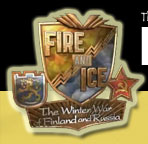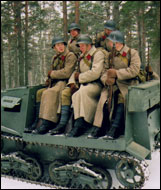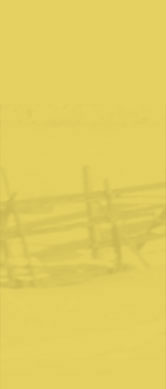

Mortar | Anti Tank | Artillery | Grenades
The mortar of Finland was the 81 Krh/38, an 81mm mortar manufactured by the famous Finnish Tampella factory. The Finns did have other mortars in their depots, but the 81mm had been designated as the standard issue. The Tampella 81mm mortar was of excellent quality and it was exported to other nations. It was a very effective weapon and provided the Finns with needed firepower. The Finns also made use of 82mm and 120mm mortars that were captured from the Red Army during the War.
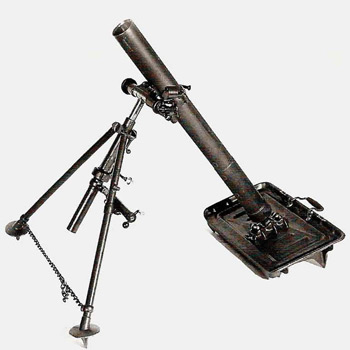
The
Finnish 81mm mortar.
Vesa Toivonen
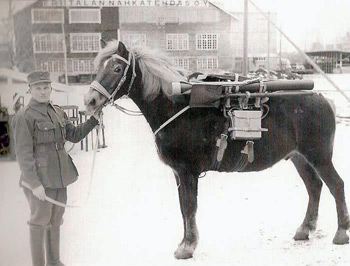
The Finnish 81mm mortar transported by horse.
Vesa
Toivonen
Finnish anti-tank capabilities were lacking leading up to the Winter War. For many years this area of Finnish defense had been under funded or ignored. The first true anti-tank gun in Finland was the Swedish Bofors Model 1937 which was designated the 37mm K/36. At the time these Swedish-made guns were considered state of the art, but armor capability was growing at rate that quickly surpassed anti-tank cannon technology. By the time of the Winter War, 48 of these cannons had arrived in Finland and domestic production had begun under license by the Valtion Tykkitehdas (State Artillery Factory or VTT) and Tampella. While production at Tampella alone was to be 100 cannons in 1938, there were many delays only 48 guns were produced. By the end of 1939, VTT had only produced 48 as well. This left Finland with a great shortage in the face of the Soviet armored onslaught. The undercarriages for the 37mm K/36 were manufactured by Wärtsilä-Yhtymä Oy Crichton-Vulkan.
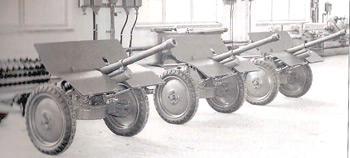
The first Tampella produced 37mm K/36' s ready for inspection August
1939.
Vesa Toivonen
It was not until September of 1939 that a prototype 20mm anti-tank
rifle, designed by Aimo Lahti, met with approval by the Finnish
Army. This prototype was to become the Lahti
Anti-Tank Rifle Model 1939 or L/39. The rifles were equipped
with a 10-round magazine and were gas operated semi-automatic.
There were only two weapons
available for Finnish issue during the Winter War, with both being
issued to the anti-tank platoon of JR-28 in the Lake Ladoga region

The
L39 anti-tank rifle in action.
Tero-Tuononen-collection
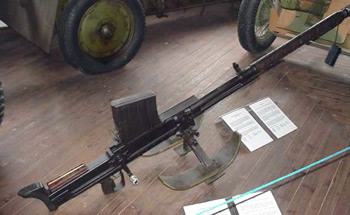
L39
Rifle at the Armor Museum, Finland.
Brent Snodgrass
The Finns bought the Madsen
20mm Anti Tank Gun from Denmark
but by the Winter War's end only 30 had arrived and all those delivered
were fitted with
anti-aircraft mounts. The Finns did convert a small amount of these
to a ski mount and they were used as anti-tank rifles; however, due
to the small caliber and lack of armor penetrating, their success
was limited. The Madsen was capable of semi automatic or fully automatic
fire.
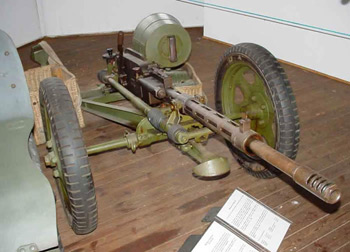
Madsen 20mm Anti Tank Gun
Brent Snodgrass
The Finnish artillery branch had suffered for many years leading to the Winter War, having to rely on outdated weapons, poor ammunition supplies and poor funding. The Finns were even forced to use a number of guns that dated to the late 1800’s. Still the Finnish artillery soldiers were well trained and very good at their duties. The commander of Finnish artillery , Vilho Petter Nenonen, is still today considered a genius in his development of artillery tactics. His ideas and theories are seen in practice in militaries around the world. While the Finnish artillery branch had few modern weapons and little ammunition, when it was able to fire it did so with great skill.
The 76 K/02, also known as 76mm Cannon Model 1902 was a Krupp design manufactured under license by Sweden. This light field gun was used in training exercises before the Winter War at the Perkjarvi training area on the Karelian Isthmus.
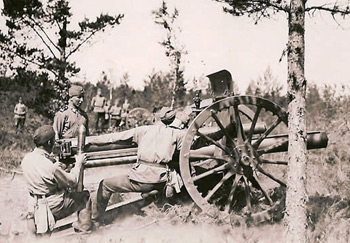
76 K/02 used in training excercises at Perkjarvi.
Brent Snodgrass
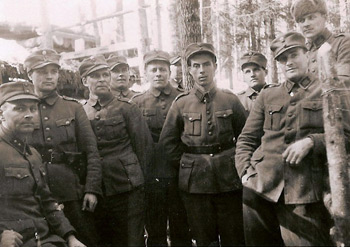
Members of a Winter War field artillery unit.
Brent
Snodgrass
The basic idea of the satchel charge was not Finnish but related to a German practice of linking together grenades to destroy or disable French and British tanks in World War I. In 1936, Finnish Capt. Kaarlo Tuurna studied this German method and decided he could improve upon it. He found that if a .5 kg of TNT was placed correctly it could penetrate 12mm of armor. The charges, known as Kasapanos in Finnish, were a very basic design of TNT packed inside a box with a sheet metal covering. This was combined with a wooden handle and a fuse system much like the design of a stick grenade. The handles and fuses could vary from charge to charge as systems could be different from factory to factory. The factory charges were produced in three sizes, ranging from two to four kilograms of TNT. There were also homemade versions of these charges that were made in the field and the construction, ignition system and power of these varied. These were sound weapons, but they were very heavy. This made the charges hard to throw over distance and forced the Finnish soldiers to get very close to the tank they wished to destroy. The main target of the charges were the tanks treads or the rear engine compartment. During training, troops used a mock satchel charge which contained wood blocks to mimic the weight of the TNT charge.
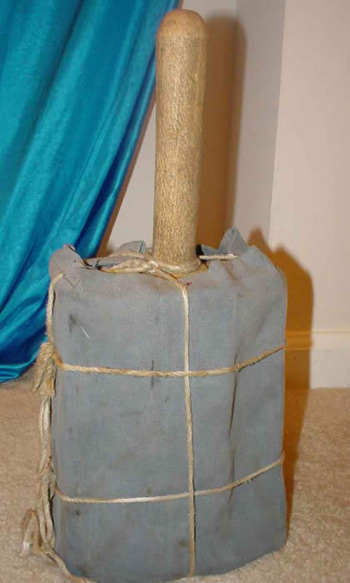
A satchel charge training device from the Winter War.
Brent Snodgrass
The first wide use of a Molotov
Cocktail weapon against armor
was during the Spanish Civil War, but it was the Finns that gave
the device its name - after Stalin’s
foreign minister. Capt Eero Kuittinen, who was the commander
of an Army
pioneer company, was the main designer of the cocktails used
in Finland. When first produced there were a number of mixtures
used
and the ignition system of these also varied. Some were simply
a rag lit by a match. Later versions used a chemical
reaction
to ignite the cocktail. The Finns had originally planed to use the
cocktail in conjunction with satchel charges but it was found that
if the cocktail was thrown into the air ducts near the engine, the
flames would be taken into the engine creating a massive fire. These
proved to be effective weapons and were much feared by Soviet tankers.
There were over 500,000 cocktails produced during the Winter War.
Finnish M32 Stick Grenade, was an offensive grenade with a metal clip that allowed the grenade to be attached to a belt. The metal segments of the grenades were produced by Oy Excelsior Ab and G.W. Sohlberg and the fuses by Oy Sytytin. The grenades were assembled at Arms Depot Three in Kuopio. The grenade’s fuse is much the same as seen in the German “Potato Masher” with an ignition time of 5 seconds. It was the most common Finnish grenade in the Winter War.
Finnish M32 multi purpose grenades could be used in a number of roles, including being modified in the field for use as a mortar round. These were not as common as the stick grenades.
Soviet RGD-33 stick grenade, a Soviet-made grenade, were captured in large numbers by the Finns in both the Winter and Continuation wars. These could be fitted with a fragmentation sleeve to increase the grenade's destructive power.
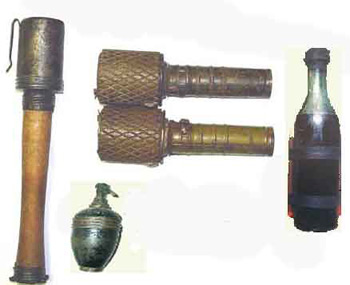
Left:
Finnish M32 Stick grenade
Bottom Middle: Left: Finnish M32 grenade
Top Middle:
Soviet RGD-33 Stick grenade (2)
Right: Molotov cocktail
Brent Snodgrass

